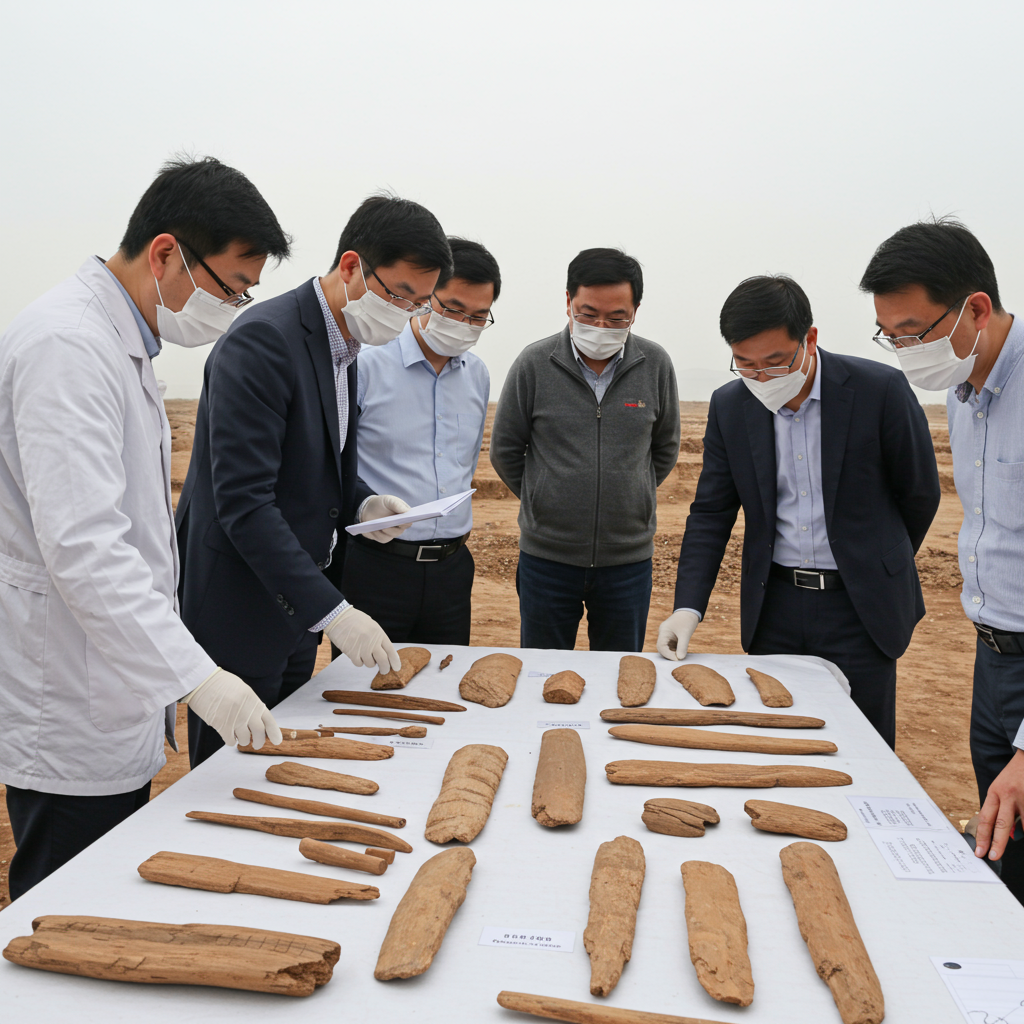A groundbreaking archaeological discovery in China is transforming our understanding of ancient human capabilities. Scientists have unearthed the oldest wooden tools ever found in East Asia. These remarkable artifacts, dating back approximately 300,000 years, offer vivid insights into the intelligence, planning skills, and survival strategies of our distant ancestors. Found preserved near an ancient lakeshore, the tools provide compelling evidence that early humans in this region made deliberate, planned journeys specifically to harvest underground edible plants.
Unearthing Ancient Secrets at gantangqing
The incredible find was made at the Gantangqing archaeological site in Yunnan province, southwestern China. Researchers discovered a collection of 35 wooden implements. These tools were exceptionally well-preserved, protected for millennia by oxygen-poor clay sediments. This rare preservation is crucial because wood typically decomposes quickly, leaving vast gaps in the archaeological record from this ancient period. Lead author Professor Bo Li from the University of Wollongong, Australia, highlighted the significance, stating this discovery “preserves a moment in time” from the Early Paleolithic period.
The Craftsmanship of Paleolithic Tools
The discovered tools showcase impressive craftsmanship. They include large digging sticks crafted from pine and hardwood. There are also smaller, hook-shaped implements. These hooks were likely used for cutting roots or perhaps loosening soil. Additionally, the assemblage features small, pointed tools. These appear designed for extracting edible plants directly from the ground. Micro-wear analysis on the tools revealed clear evidence of deliberate polishing and scraping. Soil and plant residues found on some edges provided researchers with direct clues about their function.
How Old Are the Oldest Wooden Tools?
Pinpointing the exact age of such ancient artifacts is a complex process. Researchers used advanced dating techniques to determine the age of the Gantangqing tools. Professor Bo Li, who helped develop one of the methods, utilized infrared luminescence dating on surrounding soil sediments. They also employed electron spin resonance dating on associated mammal tooth enamel. These sophisticated methods cross-validated each other. The results placed the age of the wooden tools between 250,000 and 361,000 years old. This firmly dates them to around 300,000 years ago. This age makes them the oldest wooden artifacts documented anywhere in East Asia.
Challenging Previous Notions of Early Human Technology
The discovery profoundly impacts our understanding of early human technology. For decades, some archaeologists believed that hominins in East Asia were technologically less advanced. This view often stemmed from comparisons with complex stone tools found in Western Eurasia and Africa. However, the sophisticated design and specific function of the Gantangqing wooden tools directly challenge this idea. They demonstrate that ancient East Asian hominins possessed considerable technological skill and innovation during the Paleolithic era. The crafting of specialized tools from selected wood shows a level of foresight not previously widely attributed to populations in this region at this time.
Ancient Foraging and Planned Expeditions
The types of tools found offer compelling evidence of how these early humans lived. The presence of digging sticks and root hooks strongly suggests a focus on underground plant resources. Researchers propose that the hominins living near Gantangqing strategically utilized the resources available around the ancient lakeshore. This wasn’t accidental scavenging. The existence of purpose-built tools indicates planned visits to the lakeshore area. They came prepared with instruments specifically designed for extracting underground storage organs like tubers, rhizomes, or corms. This points to advanced cognitive abilities. It shows they could anticipate needs, plan future actions, and understand the environment around them.
A Unique Plant-Based Survival Strategy
Analysis of other plant remains found at the Gantangqing site further supports the theory of a plant-focused diet. While residues on the tools were too decomposed for specific identification, the site contained evidence of foods like berries, pine nuts, hazelnuts, and kiwi fruit. Aquatic tubers were also likely part of their diet. This plant-based survival strategy contrasts notably with findings from some contemporary sites elsewhere in the world. For instance, sites like Schöningen in Germany, known for its equally ancient wooden spears, suggest that contemporary European hominins focused heavily on hunting large mammals. The Gantangqing findings reveal a different, plant-centred adaptation. This highlights the diverse ways early humans thrived in different environments, particularly the subtropical setting of Yunnan.
Who Made These Remarkable Tools?
While the specific species of hominin who created these tools is not definitively known, the timeframe and location offer clues. Around 300,000 years ago, several hominin groups existed. Based on increasing evidence of their presence and capabilities across East Asia during this period, scientists suggest that Denisovans are the most likely candidates. Discoveries like the Harbin fossil and findings from the Tibetan Plateau link Denisovans to this region at this time. Denisovans are known to have interbred with modern humans and possessed cognitive abilities sufficient for creating sophisticated tools. This hypothesis adds another layer of significance to the Gantangqing discovery, potentially linking these ancient artifacts to a fascinating and still somewhat mysterious branch of the human family tree.
The discovery of these 300,000-year-old wooden tools at Gantangqing fills a critical gap in our understanding of Paleolithic East Asia. It provides unprecedented insight into the technological prowess, environmental adaptations, and complex behaviors of early humans in the region. The tools stand as silent witnesses to planned foraging trips and a strategic, plant-based diet. They challenge previous assumptions about technological development and underscore the rich diversity of human innovation across the globe hundreds of thousands of years ago.
Frequently Asked Questions
How old are the oldest wooden tools discovered in East Asia?
The oldest wooden tools found in East Asia date back approximately 300,000 years. Discovered at the Gantangqing site in China’s Yunnan province, these 35 artifacts were dated using advanced techniques like infrared luminescence and electron spin resonance, yielding an age range between 250,000 and 361,000 years old.
What did these ancient tools from China reveal about human behavior?
The discovery reveals that ancient humans in China around 300,000 years ago demonstrated advanced cognitive skills and planning. The tools, specifically designed for digging up plants, suggest planned foraging trips to resources like lakeshores. This level of foresight and intention, combined with sophisticated craftsmanship, challenges previous ideas that East Asian hominins were technologically less advanced than those in other regions.
Were Denisovans the likely makers of the Gantangqing tools?
Based on the timeframe and location, alongside growing evidence of their presence and cognitive abilities, scientists suggest that Denisovans are the most probable creators of the Gantangqing wooden tools. While not definitively proven, this hypothesis is supported by the increasing number of Denisovan findings across East Asia dating to this period.
The Gantangqing tools represent a remarkable window into a distant past, rewriting parts of the human story in East Asia and highlighting the ingenuity of our ancient ancestors.
Word Count Check: 815




